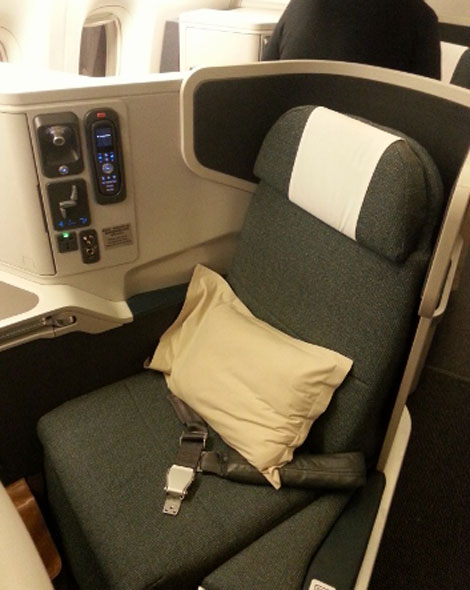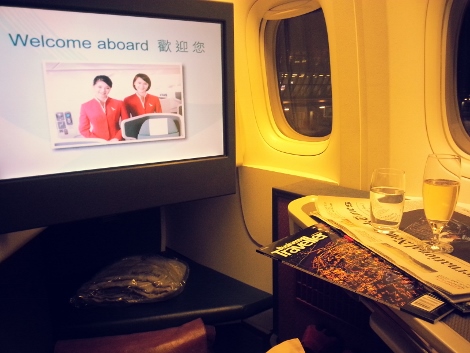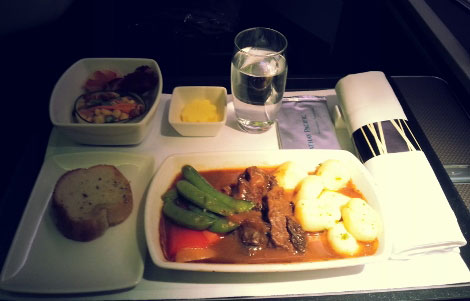CHECK-IN
I arrived at Bangkok's Suvarnabhumi Airport departure level at 1745 for the 1910 departure on flight CX702 from Bangkok to Hong Kong, a flight of two hours and 30 minutes.
Cathay Pacific opens its online check-in service 48 hours prior to departure, so I had already pre-selected my seat and was equipped with an electronic boarding pass when I proceeded to the airport. The online check-in service is both intuitive and efficient and among the best I have used.
I went to Zone M at the departure level, where Cathay was checking passengers in at ten counters – three for business class and Marco Polo Club members (the airline's loyalty program), two for bag drop only and five for economy class.
There were no queues at any of the counters at the time I visited and the entire Cathay Pacific check-in area somewhat felt like an oasis of calm in an otherwise hectic airport environment.
At check-in, I learned about a change of aircraft from an A340-300 to a B777-300ER that night, which meant that my previous seat selection could not be honoured. Nevertheless, I was assigned a window seat as far in the front as was possible, which I prefer for quick boarding and disembarking the aircraft.
I was handed my boarding pass together with a) fast track security and immigration clearance; b) personalised departure lounge invitation card for Cathay Pacific's Suvarnabhumi airport lounge; and c) personalised arrival lounge invitation card for Cathay's "The Arrival" lounge in Hong Kong.
I like that Cathay Pacific prints these personal invitation cards for passengers instead of following the usual industry practice that sees check-in agents give instructions on how to locate the lounge. It is a small effort that immediately makes the experience feel more premium.
There were no queues at the fast-track security and immigration area and I was airside in less than five minutes.
THE LOUNGE
Cathay Pacific operates its own first and business class lounge at concourse G at Suvarnabhumi Airport, next to the Oneworld partner lounges of British Airways and Qantas. Note that it takes approximately ten to 15 minutes to walk from the fast-track immigration to the lounges.
Having visited the Cathay Pacific lounge many times before, I decided to try the recently refurbished Qantas lounge.
The lounge was tastefully furnished with white, blue and brown sofas, chairs, coffee tables and high tables offering seating for up to 120 passengers. Qantas opens this lounge up to passengers of its new partner airline Emirates as well, which had two flights leaving that evening.
That being said, the lounge was rather busy but it was not a problem finding a place to sit and there were many members of staff quickly clearing tables and replenishing buffet items.
The buffet itself was a nice selection of Asian and western hot and cold dishes. There were two soup options, a Thai curry, a stew, various types of meat skewers, crab cakes, an assortment of canapes and a salad bar. I did not try any of the foods but observed that a lot of other passengers seemed to enjoy the offerings for they went for seconds and thirds.
There was also a wide array of soft drinks, fresh juices, wines, spirits and, notably, two varieties of Moet Champagne available.
BOARDING
There are no boarding announcements in the lounge, which I left at 1840 for the 1910 departure of my flight to Hong Kong.
Boarding was through Gate E1, a less-than-five-minute walk from the lounge. Boarding was slightly delayed and started at 1850. Priority boarding for business class and members of the Marco Polo Club worked flawlessly and I was one of the first passengers onboard the aircraft.
I was shown to my seat and given assistance with stowing my bag. Hot towels, water, freshly-squeezed orange juice and Champagne were offered.
A very large selection of international newspapers and magazines was available on shelves in the front of the cabin.
THE SEAT
This short regional flight of two hours and 30 minutes was operated by the B777-300ER, Cathay Pacific's latest long-haul aircraft that is replacing its B747-400s.
There are 53 business class seats installed on this aircraft; they are the new style seats introduced in late 2010. Seating is in a 1-2-1 configuration.

Business class spreads across two cabins, a very small one of only two rows (11 and 12) and then the main cabin (rows 15 to 26). The seats are in A-D-G-K. I was in seat 11K, a window seat in the small front cabin. For a seat plan of this aircraft, please click here.
All seats are angled slightly, so window seats face a window. The middle seats (D-G) are angled inwards, but have been cleverly designed so you are not forced into making eye contact with your neighbour.
The seat has a real sense of space to it, both in terms of how wide it is and also the general privacy and airiness of the design. Since the seat is angled sideways, there is a triangular bit of seat cushion to one side between the seat and the armrest. This armrest is lowered for take-off and landing, but is really a psychological thing since the seat is so wide would have to be very wide yourself to manage to rest your elbow on it.
The seat reclines to meet a footrest, and if you only partially recline the seat this brings it into reach of your feet for a comfortable reading position, or one from where you can watch the 15.4-inch IFE screen, which pops out from the angled back of the seat in front of you.
All the controls for the seat and the IFE are in a convenient position to one side at shoulder height along with a reading light which has two levels of brightness, and the in-seat power (universal) and iPod USB jacks are here as well.

There is a large storage space beneath where the table appears from — although this has to be left empty for take-off and landing, and the table itself is good and firm. It also slides out from the armrest and slides back in, so you don't have to lift it up into a vertical position to put it away and can get out of the seat by only pushing it slightly to one side, a nice touch.
There is also a side table next to this where you can store a lot of things during the flight and even a small area which is to one side of the seat near the floor with a sliding door. This is a good spot for your shoes — I wouldn't put anything else in there because it would be too easy to forget it.
All seats are now also equipped with a multimedia outlet that allows passengers to connect their iPods and iPads to the system, or they can charge their personal devices.
In order to view or listen to the contents on their Apple gadgets on the IFE screens, passengers need to ask the cabin crew for a special cable and once connection is made, the device becomes the remote control. To charge the battery of a device, however, any regular USB cable would do.
WHICH SEAT TO CHOOSE
I enjoyed the extra sense of privacy and calm in the small front cabin. Having said that, I would recommend any seat in row 11 or 12.
All of the seats have the advantage of having direct aisle access. If you are travelling as a couple, then the centre seats are for you, if travelling alone, I would go for the window seats (A or K). Some of these have two windows to look out of, some have one (row 25 for instance).
THE FLIGHT
We pushed back a few minutes behind schedule and eventually took off at 1930, 20 minutes late. The cockpit kept us updated every five minutes or so, which I appreciated.
The cabin purser introduced herself as Queenie and went from seat to seat to personally greet all passengers in business class (by name), a nice touch typical of Cathay Pacific.
The IFE, Cathay's Studio CX, was switched on as soon as the seat belt sign went off. What surprised me was that there were no movies to choose from. Being a regular user of Studio CX I know that there are usually hundreds of movie options available in a number of Asian and Western languages. Given the duration of the flight, only TV shows and documentaries were shown though, which I found a little disappointing as surely one could finish most movies in less than two hours.
I was not much interested in the TV shows and documentaries selection as I had either never heard of them before or had seen them previously. So I switched the screen to flight map mode and did some work while waiting for the dinner service to commence.

Dinner menus were distributed when the seat belt sign came off and read as follows:
Appetizer
- Som tum corn salad with prawn
Main Courses
- Stir-fried pork neck slice with onion, ginger and wood ear, steamed jasmine rice, pak choy and carrot flowers
- Slow-cooked beef with morel red wine sauce, herb gnocchi and roasted vegetables
- Thai green curry fish cake with eggplant, steamed jasmine rice and mixed vegetables
Dessert
- Haagen-Dazs ice cream
- Pralines
Dinner service started a lot later than I had expected. An hour into the flight there were still no signs of food and I was growing increasingly hungry.
After one hour and 20 minutes (with just over an hour to go to Hong Kong) the cabin crew came around with a cart displaying all three available main course options. I really like the way this is done because of the flexibility and spontaneity this offers. For instance, when I first saw the menu I decided to have the pork neck, but changed my mind when seeing that the beef looked more appetising — we eat with our eyes after all.
The cart also came stocked with beverages and a bread basket, so within seconds I had a full meal assembled in front of me.
The appetiser was tasty but consisted mostly of corn and was not nearly as flavourful as you would expect from a Thai som tum salad.
The slow-cooked beef was very good. It was just firm enough to stay in pieces but would nicely break apart when lightly touched with a knife and fork. The morel red wine sauce matched the beef perfectly and the gnocchi were of good texture — firm, but soft nonetheless — and were a great means to soaking up the delicious sauce. The roasted vegetables were unfortunately overcooked.
The tray was cleared soon after I had finished and coffee and tea, as well as digestif orders, were then taken. Those arrived with a selection of four different Haagen-Dazs ice cream cups and Godiva pralines.
An altogether satisfying dining experience that was only lessened by starting late.
Queenie came around once again to see if everything was in order, I had enjoyed the dinner and to check if I required any kind of special assistance for arrival into Hong Kong.
ARRIVAL
The captain came on some 20 minutes before arrival into Hong Kong and informed us that, in spite of our late departure, we were due to land some 20 minutes ahead of schedule. He then chatted for a good minute or so about the weather and the forecast for the next couple of days.
We did land early as promised and quickly disembarked the aircraft through Gate 2 at Hong Kong International Airport, from where it was a short walk of three minutes to immigration and luggage reclaim.
I was at the luggage carrousel no later than 15 minutes after touch-down and had to wait less than ten minutes for my suitcase to arrive — it was the first on the belt.
VERDICT
A very good experience. Cathay Pacific gets it right.
There are areas for minor improvements (i.e. starting the dinner service earlier and offering the full Studio CX selection even on shorter flights) but looking at the big picture it is hard to fault the airline's new business class product, the cabin crew and the on-the-ground service.
It is the attention to detail that really makes me appreciate Hong Kong's home carrier — the fact that every member of cabin crew addresses you by name, makes a genuine attempt at interacting with you, is intuitive and attentive about your needs and is just generally very friendly. Add to that engaged communications from the cockpit, a fantastic seat and ample reading materials and you have got a winner.
As Cathay operates an all wide-body fleet of aircraft, even a short regional hop like this one from Bangkok to Hong Kong becomes a very comfortable premium service, absolutely incomparable with what passengers would experience on most other regional airlines (on regional aircraft), let alone with what the vast majority of European and US carriers offer.
FACT FILE
- PLANE TYPE B777-300ER
- CONFIGURATION 1-2-1
- SEAT WIDTH 21in
- SEAT LENGTH 205cm
- SEAT RECLINE 180 degrees
- PRICE Internet rates for a return business class flight from Bangkok to Hong Kong in March start from £520
- CONTACT cathaypacific.com
Dominic Lalk








